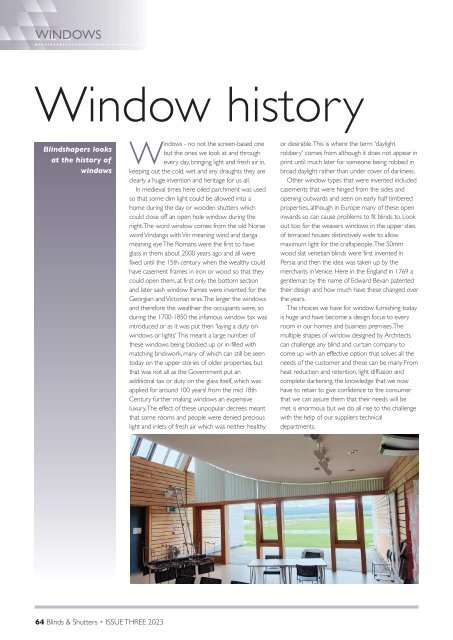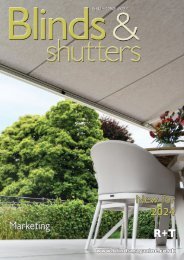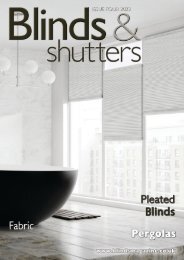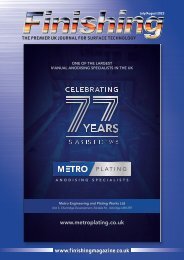Blinds & Shutters - Issue 3/2023
Summer seems to have arrived and I imagine it’s peak season for companies that are involved in the awnings and solar shading markets. There seems to a lot of choices out there and it will be interesting to see how the home improvement market copes with the increasing of interest rates over the last few months. Lots of fixed mortgage rates are coming to an end, from historically low levels, so it way create another shock to consumers. So fingers crossed that it’s not as bad as some economists would have us believe and hopefully the rest of the summer will be long and hot!
Summer seems to have arrived and I imagine it’s peak season for companies that are involved in the awnings and solar shading markets.
There seems to a lot of choices out there and it will be interesting to see how the home improvement market copes with the increasing of interest rates over the last few months.
Lots of fixed mortgage rates are coming to an end, from historically low levels, so it way create another shock to consumers. So fingers crossed that it’s not as bad as some economists would have us believe and hopefully the rest of the summer will be long and hot!
Create successful ePaper yourself
Turn your PDF publications into a flip-book with our unique Google optimized e-Paper software.
WINDOWS<br />
Window history<br />
<strong>Blinds</strong>hapers looks<br />
at the history of<br />
windows<br />
Windows - no not the screen-based one<br />
but the ones we look at and through<br />
every day, bringing light and fresh air in,<br />
keeping out the cold, wet and any draughts they are<br />
clearly a huge invention and heritage for us all.<br />
In medieval times here oiled parchment was used<br />
so that some dim light could be allowed into a<br />
home during the day or wooden shutters which<br />
could close off an open hole window during the<br />
night. The word window comes from the old Norse<br />
word Vindanga with Vin meaning wind and danga<br />
meaning eye The Romans were the first to have<br />
glass in them about 2000 years ago and all were<br />
fixed until the 15th century when the wealthy could<br />
have casement frames in iron or wood so that they<br />
could open them, at first only the bottom section<br />
and later sash window frames were invented for the<br />
Georgian and Victorian eras. The larger the windows<br />
and therefore the wealthier the occupants were, so<br />
during the 1700-1850 the infamous window tax was<br />
introduced or as it was put then 'laying a duty on<br />
windows or lights' This meant a large number of<br />
these windows being blocked up or in-filled with<br />
matching brickwork, many of which can still be seen<br />
today on the upper stories of older properties, but<br />
that was not all as the Government put an<br />
additional tax or duty on the glass itself, which was<br />
applied for around 100 years! from the mid 18th<br />
Century further making windows an expensive<br />
luxury. The effect of these unpopular decrees meant<br />
that some rooms and people were denied precious<br />
light and inlets of fresh air which was neither healthy<br />
or desirable. This is where the term 'daylight<br />
robbery' comes from although it does not appear in<br />
print until much later for someone being robbed in<br />
broad daylight rather than under cover of darkness.<br />
Other window types that were invented included<br />
casements that were hinged from the sides and<br />
opening outwards and seen on early half timbered<br />
properties, although in Europe many of these open<br />
inwards so can cause problems to fit blinds to. Look<br />
out too for the weavers windows in the upper sties<br />
of terraced houses distinctively wide to allow<br />
maximum light for the craftspeople. The 50mm<br />
wood slat venetian blinds were first invented in<br />
Persia and then the idea was taken up by the<br />
merchants in Venice. Here in the England in 1769 a<br />
gentleman by the name of Edward Bevan patented<br />
their design and how much have these changed over<br />
the years.<br />
The choices we have for window furnishing today<br />
is huge and have become a design focus to every<br />
room in our homes and business premises. The<br />
multiple shapes of window designed by Architects<br />
can challenge any blind and curtain company to<br />
come up with an effective option that solves all the<br />
needs of the customer and these can be many. From<br />
heat reduction and retention, light diffusion and<br />
complete darkening, the knowledge that we now<br />
have to retain to give confidence to the consumer<br />
that we can assure them that their needs will be<br />
met is enormous but we do all rise to this challenge<br />
with the help of our suppliers technical<br />
departments.<br />
64 <strong>Blinds</strong> & <strong>Shutters</strong> • ISSUE THREE <strong>2023</strong>

















